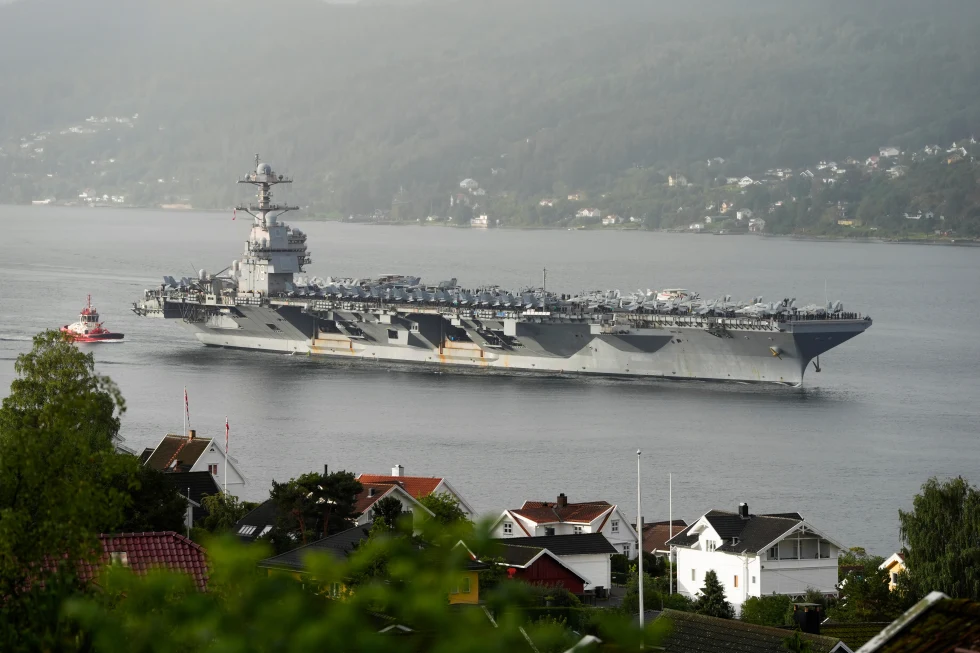Trump Deploys Aircraft Carrier to South America, Leaving Mideast and Europe Without U.S. Presence
President Donald Trump’s decision to shift the nation’s most advanced aircraft carrier to South America in his campaign against drug cartels is pulling the ship out of the Mediterranean Sea at a time when a fragile ceasefire between Israel and Hamas is under strain from renewed strikes in Gaza.
The U.S. now finds itself in the rare position of having only a single carrier deployed — and none in the waters off both Europe and the Middle East. The move marks a stark change from earlier this year, when American carriers were heavily involved in combat operations alongside Israeli forces and in countering Yemen’s Houthi rebels in the Red Sea.
The new orders for the USS Gerald R. Ford highlight the administration’s increasing focus on the Western Hemisphere, reflecting a shift in U.S. priorities as military pressure intensifies on drug trafficking routes in South America. Trump called the move a “decisive step” in dismantling transnational cartels that threaten the U.S. homeland.
A Major Strategic Shift
Speaking aboard another carrier, the USS George Washington in Japan, Trump praised U.S. naval operations and vowed to “stop the drugs coming in by land.” The move underscores the White House’s growing emphasis on Latin America as a strategic focus, even as conflicts persist in the Middle East.
Mark Cancian, a senior adviser at the Center for Strategic and International Studies and a retired Marine colonel, said the decision shows the limits of America’s naval reach. “It’s such a powerful and scarce resource,” Cancian said. “There will be a lot of pressure to redeploy if peace negotiations collapse in the eastern Mediterranean or tensions rise with Iran.”
Rising Tensions and Regional Impact
While the USS Nimitz heads home for decommissioning and the USS Theodore Roosevelt conducts training off San Diego, the Ford’s redeployment leaves no U.S. carrier in the Middle East — just as violence has flared again in Gaza despite a Trump-brokered ceasefire. The Israeli army resumed airstrikes Tuesday amid growing tension with Hamas.
Pressure on Venezuela
The U.S. military’s buildup near Venezuela, including 13 fatal strikes on suspected drug boats, has fueled speculation about Trump’s intentions toward President Nicolás Maduro. Secretary of State Marco Rubio said the operation is strictly counter-narcotics but accused Maduro’s government of “actively aiding the drug trade.”
Maduro, meanwhile, has accused Washington of fabricating a pretext for war. “They are manufacturing a criminal, totally false narrative,” he said in a national address. “Venezuela does not produce cocaine leaves.”
Analysts warn that any destabilization could spiral out of control. Geoff Ramsey of the Atlantic Council said, “If Maduro loses power suddenly, Venezuela could devolve into a Libya-style collapse that lasts for years.”
Growing Military Footprint
The Ford strike group includes five destroyers and joins a U.S. naval buildup off South America. The region already hosts several U.S. warships, bombers, and F-35B fighter jets deployed to Puerto Rico. A Navy submarine capable of launching cruise missiles is also operating in the area.
Officials say U.S. forces have killed at least 57 people in strikes against vessels accused of trafficking narcotics. Trump has labeled drug cartels as “unlawful combatants,” invoking the same legal authority used after 9/11. Lawmakers have questioned the lack of congressional approval, but Trump allies argue he has full authority.
Sen. Lindsey Graham told CBS’ Face the Nation that land strikes in Venezuela are “a real possibility.” “We’re not going to sit and watch boats full of drugs head to our shores,” Graham said. “We’ll destroy them — and those who want to poison America.”


